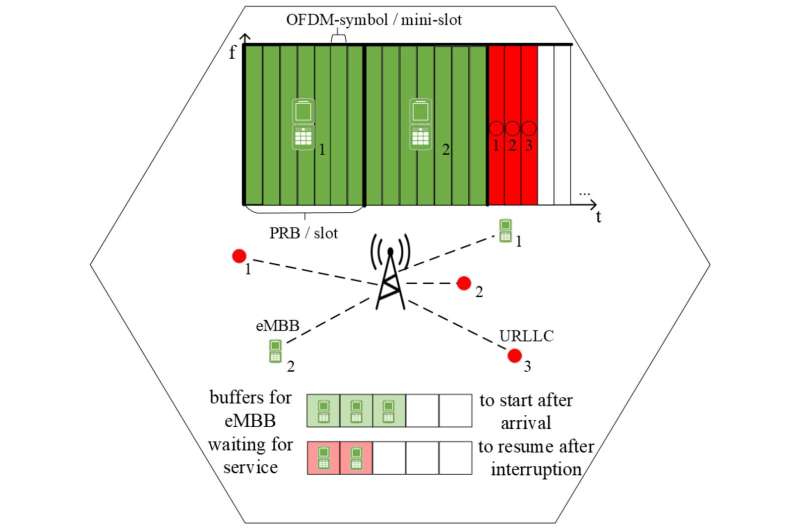Mathematicians make 5G network scheme more efficient and reliable

Mathematicians from RUDN University have proposed a new scheme for 5G networks that optimizes access to different network segments. The number of non-priority tasks awaiting the start of execution or interruption has halved, while the probability of disconnection for them does not exceed 0.1%. The results are published in the journal Mathematics.
Two key scenarios of 5G networks are Enhanced Mobile Broadband (eMBB) and Ultra Reliable Low Latency Communications (URLLC). eMBB first appeared in 4G networks providing a large data bandwidth and low latency. The innovation of 5G is URLLC. This slice of the network transmits data very quickly. It allows implementing applications of the Internet of Things, tactile Internet, and other latest technologies.
Therefore, in cases where URLLC and eMBB intersect, priority is given to the former. It reduces the quality of applications that use eMBB.
RUDN University mathematicians proposed a new scheme for allocating network resources to have URLLC in priority not losing eMBB.
“New usage scenarios require very high speeds, a large number of connected devices, and applications with ultra-low latency and high reliability. eMBB scenarios are people-oriented and involve access to multimedia content, services, and data. They require wide coverage, high user density, and high data transfer rates.
“For several scenarios to coexist, it is necessary to simultaneously provide services with different quality of service requirements. Therefore, the question arises of how to divide the frequency channel between URLLC and eMBB sessions,” Irina Kochetkova, Ph.D., Associate Professor at the Institute of Computer Science and Telecommunications of the RUDN University said.
Mathematicians used the classical scheme when sessions on eMBBB are interrupted if there is no resource left for URLLC. New eMBB sessions are then sent to the queue. Deferred and interrupted sessions constantly check whether resources have been released.
The authors have improved this approach—the verification does not happen constantly, but periodically. Plus, the “affected” eMBB sessions are waiting for their turn in more than one place. The new scheme, unlike the classic one, consists of two “orbits”—separate buffers for deferred and interrupted sessions.
RUDN mathematicians conducted a numerical experiment to verify the effectiveness of the new scheme. Two separate buffers have almost doubled the number of active eMBB sessions. At the same time, the probability of connection failure is low—only 0.1%.
“This model guarantees a successful start and end and an uninterrupted eMBB session. The scheme practically doubles the average number of active eMBB applications, while keeping the probability of interruption below one-tenth of a percent,” Irina Kochetkova, Ph.D., Associate Professor at the Institute of Computer Science and Telecommunications of the RUDN University said.
More information:
Elena Makeeva et al, Retrial Queueing System for Analyzing Impact of Priority Ultra-Reliable Low-Latency Communication Transmission on Enhanced Mobile Broadband Quality of Service Degradation in 5G Networks, Mathematics (2023). DOI: 10.3390/math11183925
Provided by
Scientific Project Lomonosov
Citation:
Mathematicians make 5G network scheme more efficient and reliable (2023, November 29)
retrieved 6 December 2023
from https://techxplore.com/news/2023-11-mathematicians-5g-network-scheme-efficient.html
This document is subject to copyright. Apart from any fair dealing for the purpose of private study or research, no
part may be reproduced without the written permission. The content is provided for information purposes only.
For all the latest Technology News Click Here
For the latest news and updates, follow us on Google News.

